You’ve mastered filigree’s delicate wirework and granulation’s precise spheres separately, but combining these ancient techniques reveals possibilities neither can achieve alone. The contrast between flowing linear patterns and textured granular surfaces creates visual depth that transforms ordinary metal into extraordinary jewelry. However, merging these methods isn’t simply about placing granules alongside wire—it requires understanding how different thermal behaviors, joining temperatures, and structural mechanics work together to prevent one technique from destroying the other.
Understanding the Fundamental Differences Between Filigree and Granulation
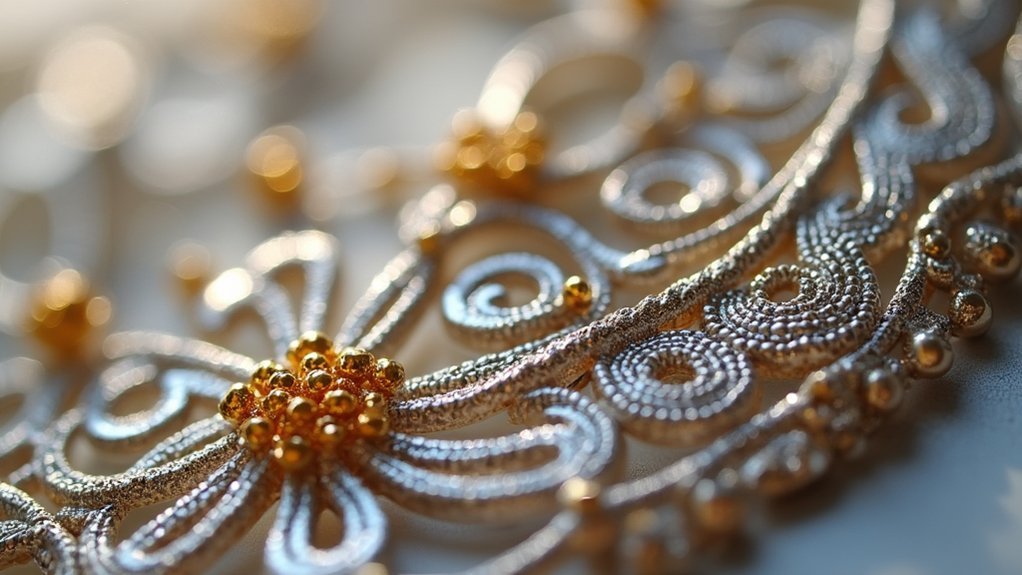
Mastery of jewelry making requires understanding two distinct metalworking techniques that couldn’t be more different in their approach.
Filigree involves twisting and soldering fine metal threads to create intricate, lace-like patterns that showcase delicate craftsmanship. You’ll work with independent wires, joining them through traditional soldering methods to build complex designs.
Filigree transforms delicate metal threads into intricate lace-like patterns through precise twisting and careful soldering of independent wire elements.
Granulation takes a completely different path. You’ll fuse tiny gold spheres directly onto metal surfaces without solder, creating rich texture and depth through careful melting processes. This technique demands precise temperature control since you’re bonding granules to base metal through fusion alone.
These contrasting methods require different skill sets entirely. While filigree relies on wire manipulation and soldering expertise, granulation demands mastery of controlled melting techniques.
Understanding both approaches opens doors to innovative jewelry combinations.
Historical Context of Combining Ancient Jewelry Techniques
When ancient civilizations discovered they could merge filigree’s delicate wirework with granulation’s textured surfaces, they revealed entirely new possibilities for artistic expression.
You’ll find these ancient techniques created a revolutionary approach to jewelry making that transcended individual methods.
Historical evidence shows how master artisans developed this combination:
- Etruscan jewelry craftsmen perfected granulation integration with filigree to showcase wealth and technical mastery
- Greek jewelers adopted these methods to craft intricate patterns depicting mythology and natural elements
- Byzantine and Islamic periods witnessed fusion techniques creating harmonious texture blends
- Cultural exchanges between civilizations enriched and evolved these combined methodologies over centuries
This artistic synergy reflects technological metalworking advancements and cross-cultural influences that shaped jewelry history.
Enhanced Visual Texture Through Contrasting Elements
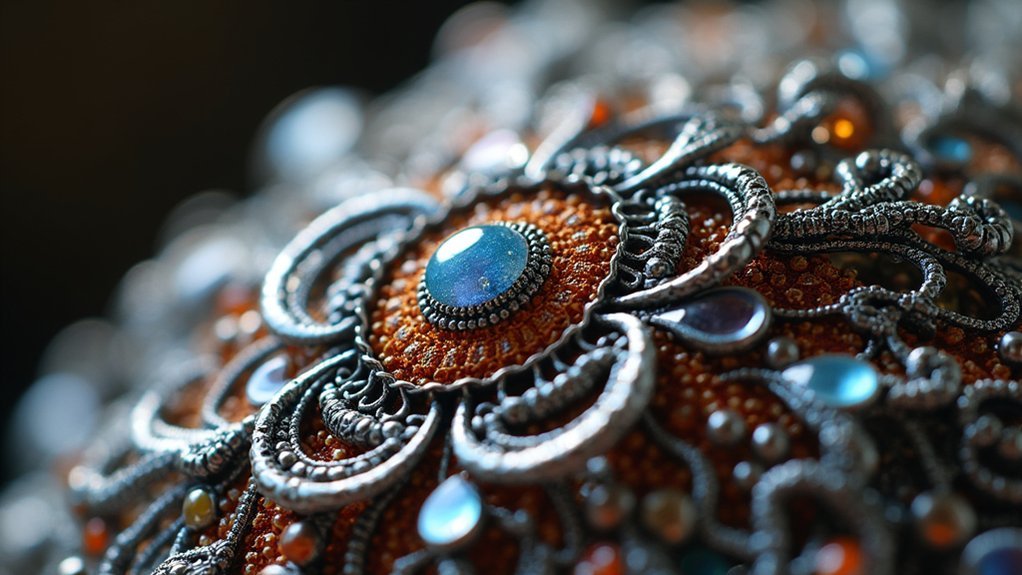
When you combine filigree’s flowing wire patterns with granulation’s spherical beads, you’re creating a striking textural contrast that immediately captures the eye.
The smooth, linear quality of wirework plays against the dimensional, tactile nature of granules, establishing visual tension that makes each technique more pronounced.
You’ll notice how light interacts differently with these contrasting elements—dancing along the wire curves while casting distinct shadows around each granule.
Wire Versus Bead Contrast
The juxtaposition of filigree’s delicate wire work against granulation’s rounded beads creates an immediate visual tension that elevates both techniques beyond their individual beauty.
You’ll notice how the hair-thin wires, measuring just 0.25mm to 0.4mm in diameter, create striking contrast against spherical granules. This interplay transforms your jewelry into something extraordinary.
The contrast between these decorative techniques offers several compelling advantages:
- Linear filigree patterns emphasize the intricate geometric precision of twisted wire
- Rounded granules provide textural depth that flat wire surfaces can’t achieve
- Light catches differently on each element, creating dynamic visual movement
- The combination showcases superior craftsmanship through technical mastery
You’re witnessing centuries-old traditions merge seamlessly, where filigree’s lace-like elegance meets granulation’s rich texture, resulting in jewelry that’s both historically significant and visually enchanting.
Light Play Dynamics
Light behaves dramatically differently across the varied surfaces of combined filigree and granulation, creating an optical symphony that transforms your jewelry with every movement. The delicate filigree wires catch and bend light in linear patterns, while granulated beads scatter illumination in multiple directions through their spherical surfaces.
| Surface Type | Light Behavior | Visual Effect |
|---|---|---|
| Filigree Wires | Linear reflection | Sharp highlights |
| Granulated Beads | Scattered diffusion | Soft shimmer |
| Combined Elements | Dynamic interplay | Layered brilliance |
This intricate layers system creates exceptional visual texture that showcases superior craftsmanship. You’ll notice how light play intensifies the contrast between techniques—filigree’s precise geometry against granulation’s organic roundness. The resulting depth and movement make each piece enchanting from every angle, demonstrating the masterful skill required for this advanced metalworking combination.
Technical Considerations for Successfully Merging Both Methods
Although filigree and granulation represent distinct metalworking traditions, merging them successfully hinges on your mastery of “The Laws of Fire”—the fundamental principles that govern how different metals and joining temperatures interact.
You’ll need precise temperature control to prevent damaging delicate filigree threads while achieving proper fusion for granulation spheres.
Your material considerations include:
- Solder selection – Use progressively lower melting point solders for filigree while planning granulation fusion points
- Traditional methods – Apply tragacanth gum to secure granules without compromising filigree integrity
- Heat sequencing – Complete higher-temperature joins first, then lower-temperature connections
- Flux or solder timing – Coordinate application to avoid interference between techniques
This careful orchestration enables you to create intricate designs combining granulation’s textural depth with filigree’s delicate patterns.
Temperature Control and the Laws of Fire in Combined Techniques
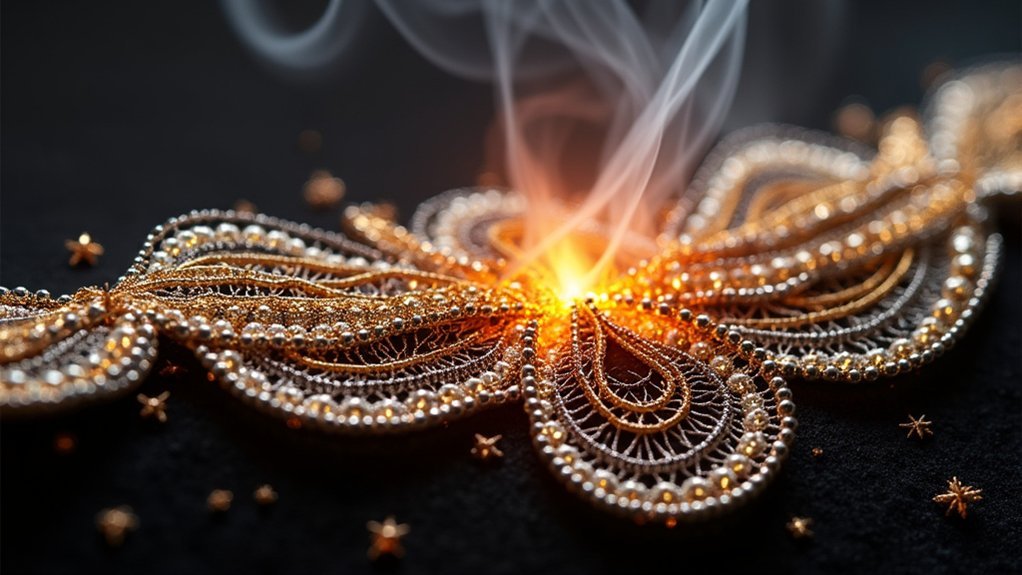
You’ll need to master temperature hierarchies when combining filigree and granulation, as granulation requires fusion at around 850°C while filigree demands progressively cooler soldering temperatures.
The Laws of Fire dictate your sequential joining operations—you must complete the highest-temperature granulation work first, then move to medium-temperature joins, and finish with the lowest-temperature filigree soldering.
Your heat management strategies become critical for controlling these distinct temperature zones without compromising either technique’s structural integrity.
Understanding Temperature Hierarchies
When combining filigree and granulation, temperature control becomes your most critical skill, as each technique demands distinct heat levels that must work in harmony rather than competition.
You’ll need to understand the melting point hierarchy to prevent disaster and achieve precise results.
The temperature hierarchy governs your success:
- Granulation fusing requires the highest temperatures to achieve proper adhesion without complete melting
- Base metal preparation needs moderate heat for initial shaping and forming
- Filigree soldering operates at lower temperatures to join delicate wire elements
- Final assembly uses the coolest temperatures to unite both techniques safely
Mastering these temperature layers lets you build complex pieces systematically.
You’ll start with granulation’s intense heat, then step down through progressively cooler operations, ensuring each previous joint remains intact while adding new elements.
Sequential Joining Operations
Sequential joining operations demand that you follow the fundamental Laws of Fire, which dictate that each successive metalworking step must use progressively lower temperatures to preserve previously completed work.
When joining granulation to filigree frameworks, you’ll start with hard soldering techniques at highest temperatures to establish your base structure. Next, you’ll apply medium-temperature operations for secondary connections, then finish with low-heat fusing to attach granules without disturbing existing joints.
Temperature control becomes critical as you progress through each stage. You must monitor heat distribution carefully to prevent melting delicate filigree wires while ensuring granules achieve proper adhesion.
This methodical approach enables innovative jewelry designs where both techniques complement each other, creating pieces with rich textural contrast and intricate patterns that showcase your mastery of sequential metalworking operations.
Heat Management Strategies
Because successful metalworking hinges on understanding thermal dynamics, you must master the precise temperature ranges that govern both filigree and granulation processes.
Temperature control becomes critical when combining these techniques, as granulation requires heating to approximately 850 degrees Celsius for proper fusing, while filigree soldering demands progressively lower melting point solders.
Effective heat management strategies include:
- Using sequential temperature applications—start with granulation’s high heat, then proceed to filigree’s lower temperatures
- Timing adjustments precisely to prevent melting delicate wire structures
- Selecting appropriate soldering materials that complement your thermal sequence
- Monitoring heat distribution to guarantee granules fuse without compromising filigree integrity
Advanced artisans develop intuitive heat management skills that enable seamless integration of both techniques, creating innovative designs with enhanced aesthetic appeal.
Creating Depth and Dimensional Interest in Jewelry Design
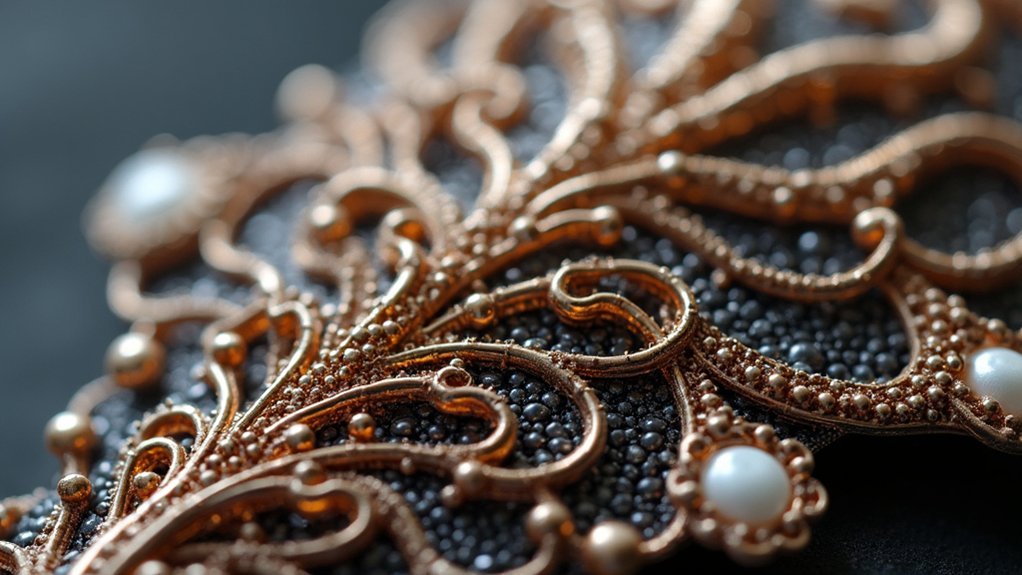
While filigree creates delicate, lace-like patterns that dance across a jewelry’s surface, the addition of granulation transforms these two-dimensional designs into enchanting sculptural compositions.
You’ll discover that strategically placed granules create focal points within the open spaces of your filigree work, drawing the viewer’s eye to specific areas.
This interplay generates remarkable textural complexity as the smooth, spherical granules contrast beautifully against the intricate linear elements.
Material Selection for Filigree and Granulation Combinations
Since the success of combining filigree and granulation depends heavily on how well your materials work together, you’ll need to carefully consider each component’s properties and compatibility.
High-karat gold, particularly 22kt, offers exceptional malleability for both techniques while guaranteeing strong bonds throughout your design.
Your material choices should include:
- Wire thickness selection – Use 0.25mm to 0.4mm hair-thin wires for filigree, with slightly thicker granules for effective granulation fusion
- Metal combinations – Pair gold with silver alloys to create striking color contrasts in your jewelry pieces
- Soldering methods – Choose hard soldering or colloidal soldering techniques based on your materials’ temperature requirements
- Bonding agents – Select tragacanth or modern adhesives to secure granules during heating processes
This careful material planning guarantees both filigree and granulation elements integrate seamlessly.
Tools and Equipment Required for Dual-Technique Work
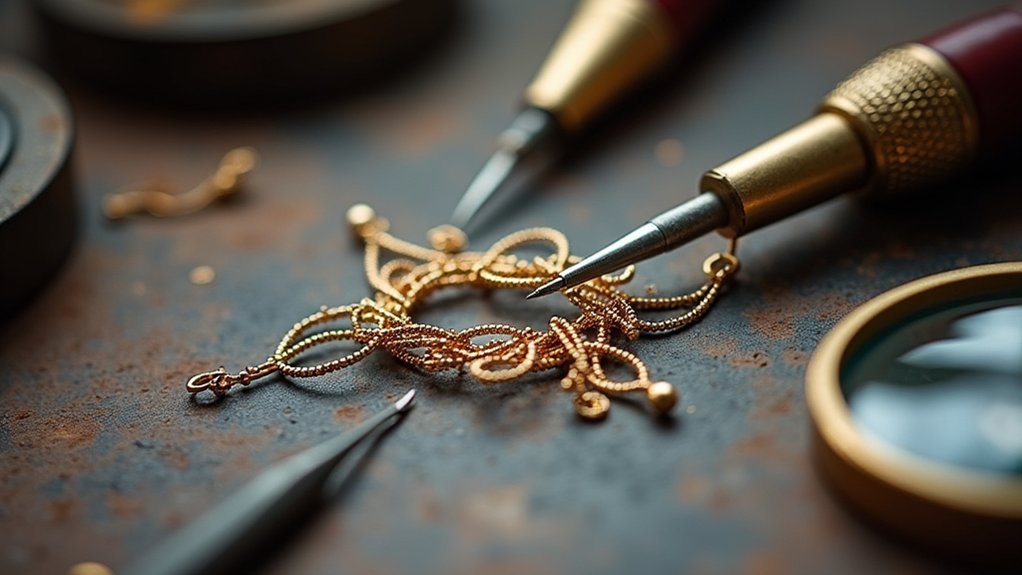
You’ll need precision pliers and specialized tweezers to manipulate the delicate wires used in filigree work without damaging their intricate patterns.
Your soldering setup must include a high-quality torch or laser fusion tool that can deliver precise heat control for joining both fine wire elements and granules.
Having multiple solders with different melting points becomes essential since filigree typically requires lower temperature joining methods than granulation work.
Essential Wire Working Tools
Precision forms the backbone of successful dual-technique jewelry work, making your tool selection critical for achieving professional results.
When combining filigree and granulation, you’ll need specialized essential tools that handle both techniques seamlessly.
Your wire working arsenal should include:
- Fine-tipped soldering torches – Enable precise heating for delicate granule placement and filigree soldering without damaging surrounding elements.
- Specialized soldering tweezers – Allow you to manipulate tiny granules and position intricate filigree components with exceptional control.
- Chain-nose and round-nose pliers – Essential for shaping fine wires and creating consistent filigree patterns while maintaining proper granule alignment.
- Measuring tools like calipers – Guarantee accurate dimensions for both granules and filigree elements, creating harmonious proportions in your finished piece.
These tools work together to achieve the precision required for stunning dual-technique jewelry.
Specialized Fusing Equipment
Beyond standard wire working tools, specialized fusing equipment transforms your dual-technique capabilities by providing the precise heat control necessary for seamlessly joining granules and filigree elements.
A precision soldering iron or laser welder gives you pinpoint accuracy when applying heat, preventing damage to delicate components during granulation work and filigree techniques.
You’ll need a digital kiln for consistent heating environments that achieve ideal fusing temperatures.
High-quality tweezers and pliers guarantee precise placement of tiny elements, while a microscope or magnifying lamp enhances positioning accuracy for intricate details.
Invest in various low-temperature solders and colloidal mixtures to accommodate different melting points between granulation and filigree components.
These specialized tools elevate your craftsmanship, enabling flawless integration of both techniques in sophisticated jewelry pieces.
Common Design Patterns That Benefit From Both Techniques
Artisans have discovered that certain design motifs naturally accommodate both filigree and granulation, creating pieces where each technique amplifies the other’s strengths.
When you combine these methods, you’ll achieve intricate designs with exceptional visual complexity and textural depth.
Several patterns work particularly well with this dual approach:
- Floral motifs – You can create delicate petals using twisted filigree wires while granulation adds realistic pollen details.
- Geometric patterns – Filigree defines clean structural lines while granulation fills interior spaces with textured contrast.
- Religious symbols – Multiple craftsmanship layers convey deeper spiritual meaning, as seen in ancient Etruscan jewelry.
- Cultural icons – Both techniques together express heritage through sophisticated metalwork traditions.
You’ll find these combinations create enchanting light play, with filigree’s openwork reflecting illumination while granulation provides dimensional shadows.
Troubleshooting Challenges When Fusing Different Methods
Although combining filigree and granulation creates stunning results, you’ll encounter unique challenges that require careful planning and execution. Understanding each metal’s melting point prevents unintentional fusion that destroys delicate filigree work.
You’ll need precise temperature control since filigree techniques demand lower soldering temperatures while granulation requires higher heat for proper fusion.
The heating process becomes critical—uneven temperatures cause misalignment and structural damage. Choose your fluxes carefully, as certain types dislodge granules during heating.
Strategic adhesive placement helps secure granules before fusion begins. Following the “Laws of Fire” guarantees proper operation sequencing, maintaining both techniques’ integrity.
When you master troubleshooting these temperature and timing challenges, you’ll create innovative designs that seamlessly showcase filigree’s delicate beauty alongside granulation’s textural richness.
Professional Examples of Successful Filigree-Granulation Pieces
When you’ve conquered those technical hurdles, you’ll find inspiration in the exceptional work of master jewelers who’ve successfully merged filigree and granulation.
Contemporary jewelry showcases these combined techniques beautifully, creating intricate designs that honor historical craftsmanship while appealing to modern collectors.
Notable examples demonstrate the power of this fusion:
- Earrings featuring delicate filigree frameworks enhanced with strategically placed granules for visual depth
- Pendants combining lace-like filigree patterns with granulated textures that reinforce structural integrity
- Historical pieces by the renowned Castellani Family, whose timeless creations continue inspiring today’s artisans
- Modern interpretations that blend both techniques using precise temperature control through the “Laws of Fire”
These masterpieces prove that combining filigree and granulation creates jewelry that’s both structurally sound and visually enchanting.
Skill Development Pathway for Mastering Combined Techniques
Since mastering both filigree and granulation demands exceptional precision, you’ll need to develop each technique independently before attempting their combination. Your skill development journey begins with creating uniform granules and twisting fine wires separately, building the foundational craftsmanship required for success.
| Learning Phase | Filigree Focus | Granulation Focus |
|---|---|---|
| Foundation | Wire twisting basics | Uniform granule creation |
| Temperature Control | Precise heat application | Fusion without damage |
| Bonding Methods | Appropriate solders | Heat-based attachment |
| Laws of Fire | Operation sequencing | Timing applications |
| Advanced Integration | Combined techniques | Artistic freedom expression |
Understanding precise heat application becomes vital as you progress. The “Laws of Fire” dictate when to apply heat and which bonding agents work best. Online courses provide structured learning paths, helping you build confidence before attempting innovative designs that showcase both techniques’ unique aesthetic qualities.
Frequently Asked Questions
What Is the Granulation Technique of Jewellery?
You’ll fuse tiny metal beads called granules onto jewelry surfaces using specialized techniques like hard soldering or colloidal soldering. This ancient method creates intricate textures and showcases your technical skill and artistry.
What Is Filigree Jewelry Used For?
You’ll find filigree jewelry used for creating intricate earrings, necklaces, and bracelets. It’s perfect for wedding rings, ceremonial pieces, and heirloom jewelry that symbolizes wealth and status across cultures.
What Is the History of Granulation Jewelry?
You’ll trace granulation jewelry back to 2500 B.C. in Sumerian Ur, where goldsmiths fused tiny gold spheres onto surfaces. Etruscans perfected this technique, creating intricate geometric patterns that influenced Greek, Roman, and later nineteenth-century artisans.
Is Filigree Jewellery Valuable?
You’ll find filigree jewelry quite valuable due to its intricate handcraftsmanship and precious metal content. Historical pieces especially command high prices, while the technique’s complexity and visual appeal make it highly sought-after by collectors.
In Summary
You’ll discover that combining filigree with granulation transforms your jewelry from ordinary to extraordinary. These contrasting techniques create depth and visual interest that’s impossible to achieve with either method alone. While you’ll face technical challenges mastering temperature control and fusion points, the results justify your effort. Your pieces will showcase advanced craftsmanship that collectors value. Don’t hesitate to experiment—this combination lets you honor traditional metalworking while developing your unique artistic voice.

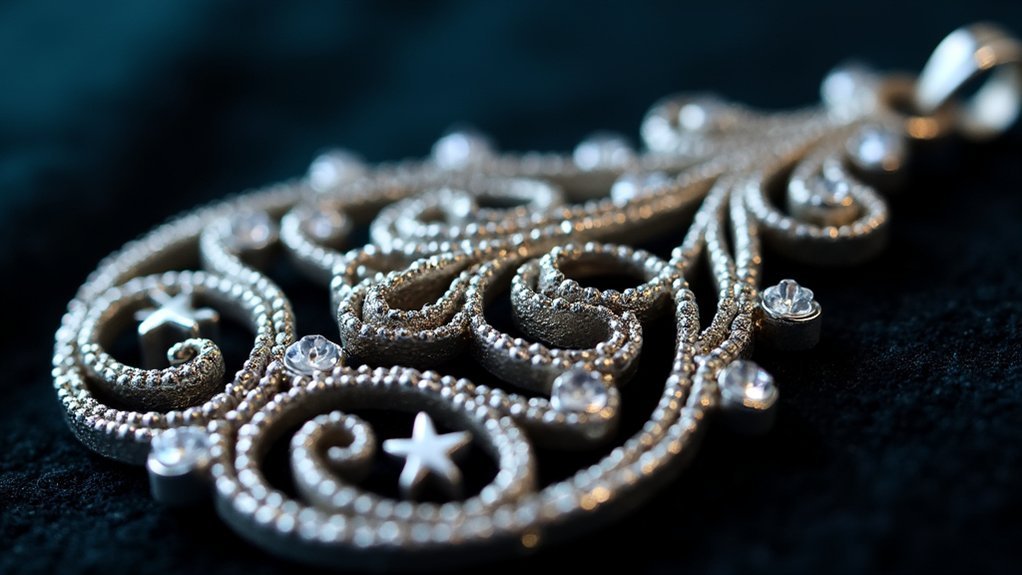
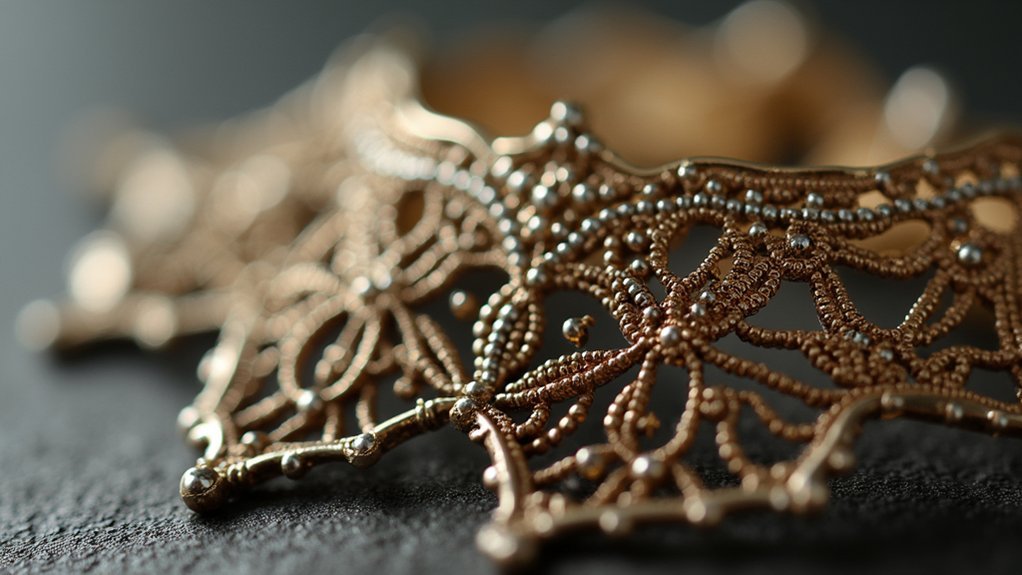
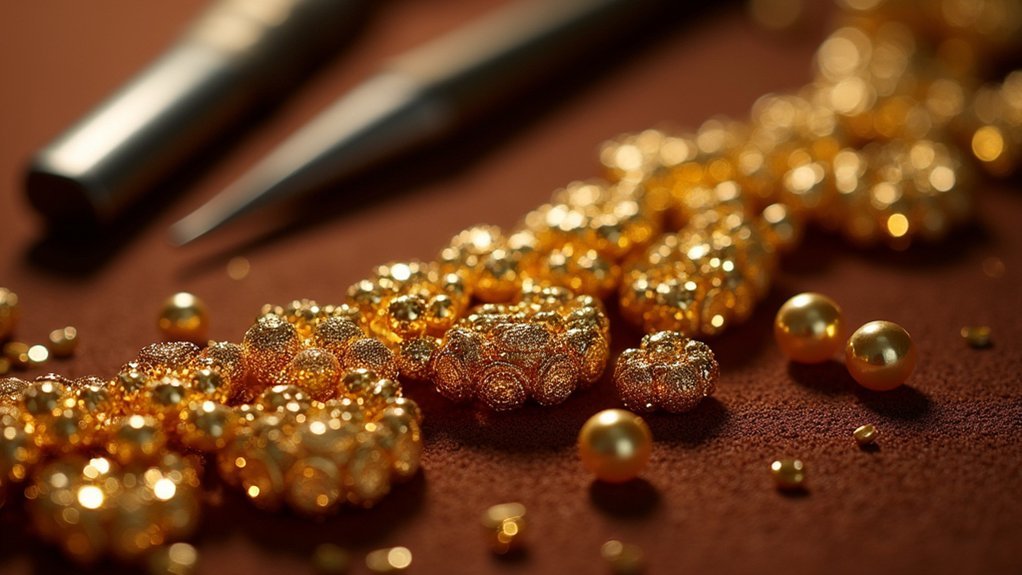
Leave a Reply